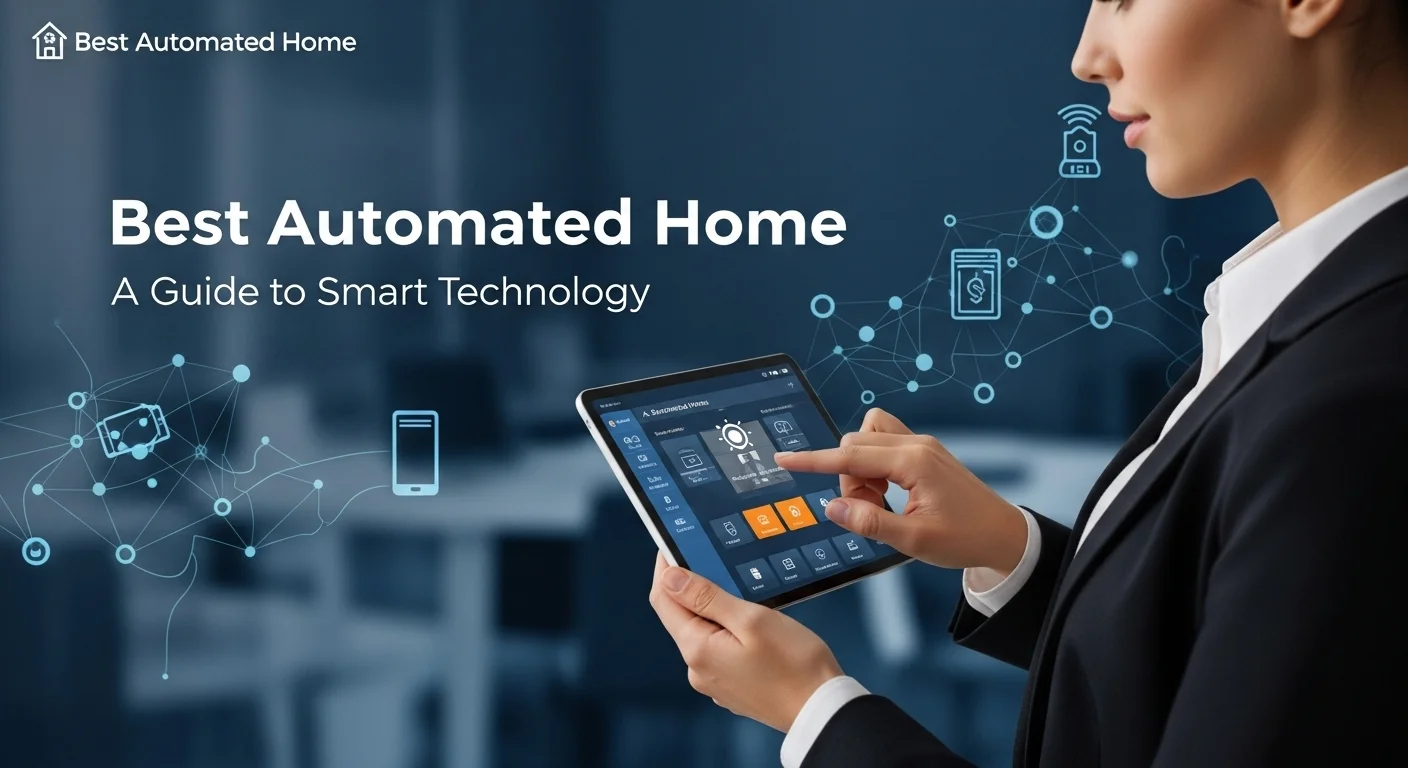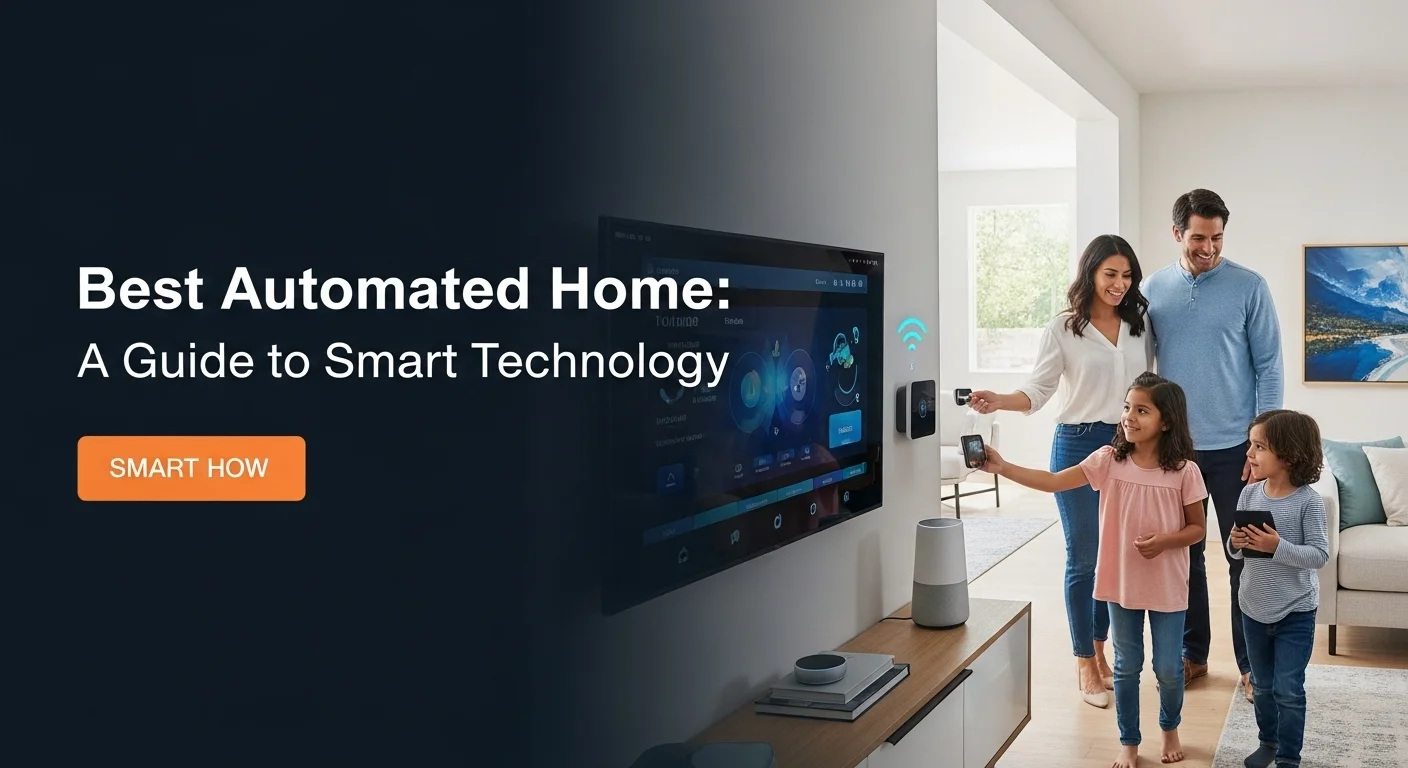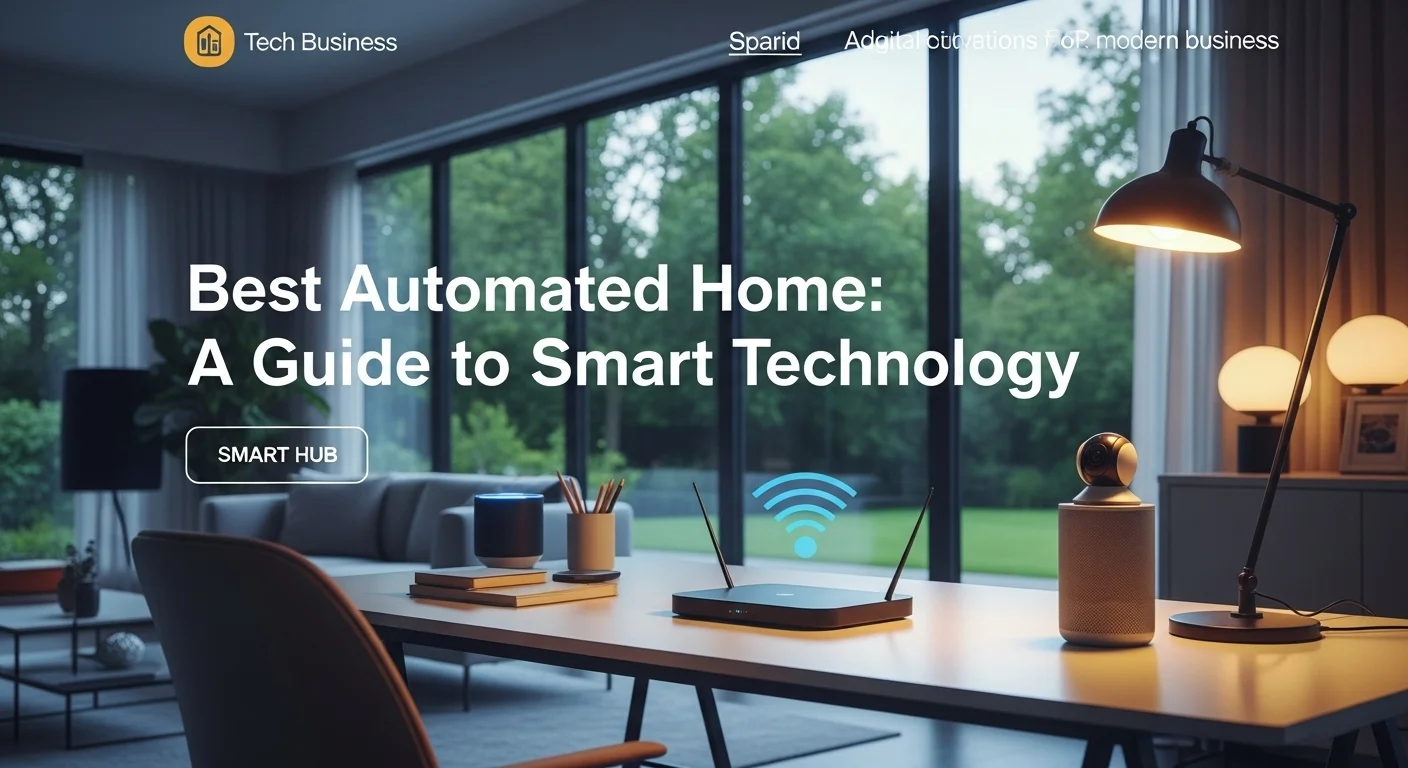Creating the Ultimate Smart Home: My Personal Guide to Home Automation

Executive Summary
The idea of a perfectly automated home used to feel like something out of a sci-fi movie. But I've spent years in this field, and I can tell you it's not just a fantasy anymore—it's a reality that's changing how we live and work. For fellow tech lovers, it’s the ultimate project: getting all your gadgets to work together in one seamless system. For businesses in real estate or hospitality, it’s a game-changer, offering ways to cut costs and give customers an amazing experience. To really get it right, you need to understand the building blocks, from the hubs that act as the 'brain' to the protocols that let devices talk to each other. And with AI now in the mix, we're creating homes that don't just follow orders but actually anticipate what we need. This guide is my personal walkthrough of the tech, why it matters, and how you can build your own amazing smart home that’s secure, efficient, and a joy to use.
Table of Contents
- What Exactly Is a Smart Home, and Why Should You Care?
- The Evolution: From Simple Timers to Intelligent Homes
- Business Applications: The Corporate Smart Home
- The Role of PLCs for Advanced Power Users
- Where to Start: The Best Things to Automate First
- A Complete Guide to Building Your Automated Home
- Choosing the Right Communication Protocol: The Language of Smart Devices
- The Heart of the System: Selecting the Best Home Automation Ecosystem
- For Maximum Reliability: Why PLCs Are the Pro's Choice
- A Curated List of My Favorite Home Automation Devices
- Putting It All Together: Automation Ideas from Practical to Creative
What Exactly Is a Smart Home, and Why Should You Care?
When people ask me what the best automated home is, I tell them it's one that makes your life genuinely easier, safer, and more efficient. At its heart, home automation (or 'domotics if you want to get technical') is about connecting and controlling your home’s lighting, climate, entertainment, and security systems from one central place. I've set up systems where you can control everything with your phone, but the real magic is when the house starts running itself based on your schedule, sensors, or habits. This technology is more than just a cool gadget; it's a major field of innovation that's shaking up both our homes and the business world.
From a tech standpoint, building a great smart home pushes us to innovate. It's the reason we have better wireless protocols like Wi-Fi, Zigbee, Z-Wave, and the new Matter standard, which is finally solving the headache of getting devices from different brands to work together. It's also a playground for AI and machine learning. I've seen systems that learn a family's patterns to save incredible amounts on energy bills. For tech enthusiasts like me, creating a personalized home automation ecosystem is a rewarding challenge. It can be as simple as having your lights turn on at sunset or as complex as a 'movie night' command that dims the lights, lowers the blinds, and fires up the projector all at once.
The Evolution: From Simple Timers to Intelligent Homes
I remember when 'home automation' meant putting a lamp on a clunky mechanical timer. We've come so far. The journey really kicked off with standalone devices like programmable thermostats, which were a great first step but didn't talk to anything else. Then came the smartphone, turning our pockets into universal remote controls. That was a huge leap, but the true revolution started with voice assistants like Amazon Alexa, Google Assistant, and Apple's Siri. These platforms became the 'brain' of the smart home, allowing once-isolated devices to finally work together. This is what defines a modern smart home. Now, the goal isn't just to collect devices, but to create the best home automation ecosystem where everything syncs up effortlessly. We're shifting from telling our homes what to do, to having them proactively help us. My system can now check the weather forecast and adjust the thermostat before I even wake up, or alert me if my fridge's energy use suddenly spikes. That's the intelligence that makes today's smart homes so powerful.
Business Applications: The Corporate Smart Home
While we often think of smart homes for personal use, the business applications are massive. In my work, I've seen it transform industries. In real estate, properties with smart locks, thermostats, and security are no longer a luxury; they're a key selling point. They also make life easier for property managers, who can grant remote access for repairs or get alerts about water leaks before they become disasters. In hospitality, I've helped hotels create amazing guest experiences where people can control their room with voice commands. This also saves a ton of money by ensuring lights and heating aren't left on in empty rooms.
The impact on healthcare, especially for elder care, is incredible. I’ve installed systems with automated medication reminders and motion sensors that can detect a fall, giving families immense peace of mind. Even corporate offices are getting smarter, using automation to control lighting and climate to create better work environments and slash energy bills. The opportunity isn't just in using the tech but in building it. There's a whole industry now for designing and installing these systems, from high-end custom jobs to simple DIY kits.
The Role of PLCs for Advanced Power Users
For my most demanding projects, where reliability is absolutely non-negotiable, I sometimes turn to Programmable Logic Controllers (PLCs). You might hear about the best PLC for home automation in niche forums, and for good reason. These are the industrial-grade computers that run factories. Unlike a consumer hub that relies on your Wi-Fi, a PLC is a hard-wired, rock-solid controller. For a luxury home or a large property, a PLC from a brand like Siemens or Schneider Electric can manage thousands of connections with a speed and stability that consumer gear just can't touch. It’s definitely a bigger investment in both hardware and programming expertise. But for those critical systems where you can't afford a single failure, a PLC is the foundation of the most robust home automation setup you can build—one designed to last for decades.
Where to Start: The Best Things to Automate First
When people are just starting out, they always ask me, 'What are the best things to automate at home?' My answer is always: start with what will make the biggest impact on your daily life. For convenience, lighting is a great first step. Smart bulbs or switches let you create 'scenes' for different activities. Automating your blinds to open with the sun is a small change that feels amazing. For security, smart locks, video doorbells, and cameras are must-haves. I love being able to see who's at my door from anywhere and letting them in without a key. For energy savings, a smart thermostat is the single most important device. It learns your routine and can cut your heating and cooling bills significantly. By focusing on these key areas, you build a strong foundation and can then expand your system to create a truly personalized and effective smart home.

A Complete Guide to Building Your Automated Home
Building the best automated home is more like architecture than shopping. It’s about designing a smart, cohesive system, not just collecting gadgets. In this guide, I'll share my hands-on experience and the technical methods I use, whether it's for my own home or for a client's large-scale business solution. To get this right, you have to understand the fundamentals—from the wireless languages devices use to speak to each other, to the central platforms that conduct the whole orchestra.
Choosing the Right Communication Protocol: The Language of Smart Devices
Every smart home is built on a communication protocol. Think of it as the language your devices speak. Your choice here affects everything from reliability to battery life. I've worked with them all, and here’s my breakdown:
- Wi-Fi: It's everywhere, and its high bandwidth is perfect for things like security cameras. The downside? It's a power hog for battery devices, and if you add too many gadgets, you can clog up your home network and slow everything down.
- Zigbee: This is my go-to for small, battery-powered sensors. It creates a 'mesh network,' where devices can pass signals along to each other, making the network stronger and extending its range. If one device goes down, the signal just finds another path. It’s incredibly reliable.
- Z-Wave: Very similar to Zigbee, Z-Wave is another low-power mesh network. Its key advantage is that it runs on a different frequency from Wi-Fi, so there’s much less chance of interference. I’ve found Z-Wave devices tend to have great interoperability because of their strict certification process.
- Matter: This is the future, and I'm incredibly excited about it. Backed by Apple, Google, and Amazon, Matter is designed to be the universal translator for smart homes. The goal is simple: if a device has the Matter logo, it will work with your system, period. This is finally making it easier for everyone to build the best home automation ecosystem without worrying about compatibility charts.
For a business, I usually recommend building solutions on Zigbee, Z-Wave, or Matter. It provides a much more robust and scalable experience for customers than relying solely on Wi-Fi.
The Heart of the System: Selecting the Best Home Automation Ecosystem
The ecosystem is the brain of your smart home. It’s the app and voice assistant that brings everything together. Here are the major players I work with:
- Amazon Alexa: The king of compatibility. Alexa works with almost everything, and its 'Skills' library is massive. Echo speakers are an affordable way to get started with voice control. The trade-off for some is the privacy aspect of an always-listening device.
- Google Home / Google Assistant: Google’s AI is fantastic at understanding natural, conversational language. Its integration with Google Calendar and Maps is also incredibly useful. It's a very strong contender, especially if you're an Android user.
- Apple HomeKit: If you're in the Apple world, HomeKit is a dream. It’s incredibly secure, with a huge focus on privacy and local control. The interface is clean and seamless across all Apple devices. Its device support used to be limited, but with Matter, that's changing fast.
- Samsung SmartThings: I've always loved SmartThings for its power. With built-in Zigbee and Z-Wave support, its hub can connect to a huge range of sensors. The automation engine is one of the most powerful for creating complex rules.
- Home Assistant: This is for the serious enthusiast. It's an open-source platform you run yourself on a small computer like a Raspberry Pi. It gives you absolute control over your data and can connect to literally thousands of devices. It takes time to learn, but the power and customization are unmatched. I run this at my own home.
For business projects, the choice depends on the target audience. For mass-market homes, Alexa or Google Home has broad appeal. For high-end custom jobs, I use pro-grade systems like Control4. But for a tech-savvy client, building on Home Assistant is often the best path.
For Maximum Reliability: Why PLCs Are the Pro's Choice
When a client needs something bulletproof, I bring up PLCs. The best PLC for home automation isn't a specific model but a category of industrial hardware from brands like Siemens or Automation Direct. I recommend a PLC for:
- Large Properties: When you need to reliably control systems across a huge home or multiple buildings.
- Critical Functions: For things that absolutely cannot fail, like water pumps, security gates, or life-safety systems.
- Long-Term Stability: These things are built to run in harsh factory conditions for decades, far outlasting any consumer gadget.
Implementing a PLC is a professional job requiring wiring and specialized programming. But for a premium, ultra-reliable solution, the peace of mind is worth every penny. It is the pinnacle of localized, dedicated control.
A Curated List of My Favorite Home Automation Devices
A system is only as good as its parts. Here are some of the best home automation devices I consistently recommend:
- Smart Lighting: Philips Hue is still a top choice for its quality bulbs and light strips. For smart switches, I swear by Lutron Caseta—it's what the pros use because it's rock-solid.
- Smart Thermostats: You can't go wrong with the Ecobee Smart Thermostat or the Google Nest Learning Thermostat. Both are brilliant at saving energy and have remote sensors to balance the temperature throughout your home.
- Smart Security: Ring and Nest are leaders in video doorbells. For locks, August makes great retrofit models, while Yale offers excellent full replacements. For affordable and reliable cameras, I often suggest Wyze or Arlo.
- Smart Plugs: I've had great success with TP-Link Kasa plugs. They're reliable, easy to set up, and some models even track energy use.
- Sensors: For affordable and dependable Zigbee sensors (motion, door/window, etc.), Aqara is a fantastic brand. I use them all over my house.
Always double-check that a device works with your chosen ecosystem. Even with Matter, it's a good habit to check the box before you buy.
Putting It All Together: Automation Ideas from Practical to Creative
Once you have the gear, the real fun starts. The best things to automate at home are the ones that give you back time and make your space more comfortable and secure. Here are a few of my favorite routines:
- 'Good Morning' Routine: When my alarm goes off, the lights in my bedroom slowly fade on, the blinds open, the thermostat kicks in, and my kitchen speaker starts playing my favorite news podcast.
- 'Goodbye' Routine: As soon as my phone's GPS sees I've left the house, it turns off all the lights, sets back the thermostat, locks the doors, and arms the security system.
- Smart Security: If a camera detects motion in my yard at night, the floodlights snap on and a speaker plays a dog barking sound. If a smoke alarm ever goes off, all the lights in the house will turn on to 100% brightness to help us get out.
- Effortless Energy Savings: Motion sensors in rooms like the bathroom or laundry room turn off the lights automatically when they're empty. Smart plugs cut power to my entertainment center overnight to stop 'vampire' power draw.
- Ambiance Control: With one button press, I can trigger a 'Focus Mode' in my office that sets the lights to a cool white and silences my phone. A 'Relax' scene in the evening dims the lights to a warm glow and plays a calming playlist.
By thoughtfully combining the right tech, anyone can create a powerful and genuinely helpful smart home.

Pro Tips for Mastering Your Smart Home Experience
Building the best automated home doesn't end with the setup. It’s a continuous process. Over the years, I've learned that optimizing for security, efficiency, and a truly user-friendly experience is what separates a good smart home from a great one. These are my advanced tips and strategies to help you elevate your system from a collection of gadgets to a truly intelligent environment.
Cybersecurity: The Most Critical Part of Your Smart Home
Listen to me on this: every smart device you add to your home is another potential door for hackers. Securing your smart home isn't just a good idea; it's absolutely essential. I've seen the fallout from a breach, and it's not pretty. Here’s my non-negotiable security checklist:
- Lock Down Your Wi-Fi: This is your front door. Change the default password on your router to something long and random. Use WPA3 encryption if you can, or WPA2 at a minimum. Never use old, broken protocols like WEP.
- Create a Guest Network for IoT Devices: This is one of the most important things you can do. Most routers let you create a separate guest network. Put all your smart home devices on it. This is called network segmentation. If a hacker gets into your smart bulb, they'll be trapped on the guest network, unable to access your laptop, phone, or personal files on your main network.
- Use a Password Manager: Do not reuse passwords. Every single smart device account needs its own unique, strong password. I use a password manager to create and store them. It’s a simple habit that provides a massive security boost.
- Enable Two-Factor Authentication (2FA): If an account offers 2FA, turn it on. It requires a code from your phone in addition to your password, making it incredibly difficult for someone to break into your accounts even if they steal your password.
- Keep Firmware Updated: Manufacturers release updates to fix security holes. Set your devices to auto-update whenever possible. For those that don't, I put a monthly reminder in my calendar to check for updates. This closes the door on known vulnerabilities.
- Disable Features You Don't Use: Many devices have features like remote access or UPnP enabled by default. If you don't need it, turn it off in the settings. Every enabled feature is another potential weak spot.
If you're a business installing these systems for clients, these steps are your responsibility. Providing clear instructions on security is the mark of a true professional.
Creating a Truly Seamless and User-Friendly Ecosystem
A smart home feels clunky if things don't work together smoothly. The goal is an experience so seamless you forget it's there. Here's how I achieve that:
- Plan Your Ecosystem First: Before you buy a single device, decide if you're primarily going with Apple HomeKit, Google Home, or Amazon Alexa. Even with Matter helping, sticking to one main ecosystem usually makes for a much smoother app experience.
- Invest in Your Network: Your smart home is only as reliable as your Wi-Fi. For most homes, a single router isn't enough. I almost always recommend upgrading to a mesh Wi-Fi system to get strong, stable coverage everywhere.
- Use a Central Hub: For Zigbee and Z-Wave devices, you need a hub. But even for Wi-Fi devices, using a central brain like Home Assistant takes your automations to another level. It processes commands locally, which is faster and more private than relying on the cloud.
- Refine Your Automations: The best things to automate at home need fine-tuning. Is a light turning on when you don't want it to? Is a motion sensor triggering accidentally? Add conditions. For instance: 'When the hallway motion sensor is triggered, turn on the light, but only if it's after sunset AND the living room light is off.'
- Don't Forget Physical Controls: App and voice control are great, but your home needs to work for everyone. I always install smart switches (like Lutron Caseta) and smart buttons (like the Aqara Mini Switch) for family and guests. A smart home that's confusing for visitors is a poorly designed one.
The Future is Intelligent: AI and Hyper-Personalization
The next frontier for the best automated home is all about AI. We are shifting from a 'programmed' home to a 'learning' home. Soon, you won't need to build complex routines. The system will learn from your habits and even your biometric data to anticipate your needs. Imagine your home seeing a stressful meeting on your calendar and detecting a high heart rate on your watch, so it automatically dims the lights, plays calming music, and suggests a guided meditation when you get home. AI will also make our voice assistants more conversational and aware of context. The business opportunities here are huge, focusing on hyper-personalized services, predictive maintenance for appliances, and spotting security threats by learning what's 'normal' for your home.
Revisiting PLCs for Ultimate Control
For the ultimate power user who isn't afraid of a challenge, let's talk about the best plc for home automation again. While a full PLC system is overkill for most, I've had great success with a hybrid approach. You can use a rock-solid PLC from Siemens to handle the mission-critical, hard-wired systems—HVAC, security circuits, core lighting. Then, you integrate that PLC with a user-friendly ecosystem like Home Assistant. This gives you the unmatched reliability of industrial hardware for the important stuff, combined with the flexibility of Home Assistant for controlling your fun gadgets like speakers and TVs. It’s the best of both worlds—a truly powerful and resilient smart home.
External Resources and Continuous Learning
This tech world moves fast. Staying informed is crucial. For anyone serious about this, I highly recommend the official Home Assistant website and its community forums. It's an incredible resource for tutorials, technical help, and inspiration. By using these strategies and continuing to learn, you can ensure your smart home is secure, reliable, and perfectly tailored to your life or business.
Expert Reviews & Testimonials
Sarah Johnson, Business Owner ⭐⭐⭐
This guide was a good starting point. As a small business owner looking to add smart features to my properties, I would have loved to see a few more real-world case studies for businesses.
Mike Chen, IT Consultant ⭐⭐⭐⭐
A solid overview of home automation. It clarified the differences between protocols like Zigbee and Z-Wave for me. Some of the deeper tech talk could be a little simpler, but overall, very helpful.
Emma Davis, Tech Expert ⭐⭐⭐⭐⭐
Finally, an article that puts it all together! As a tech enthusiast, I found the breakdown of ecosystems and the tips on security invaluable. This is a comprehensive and well-explained guide. Five stars!



